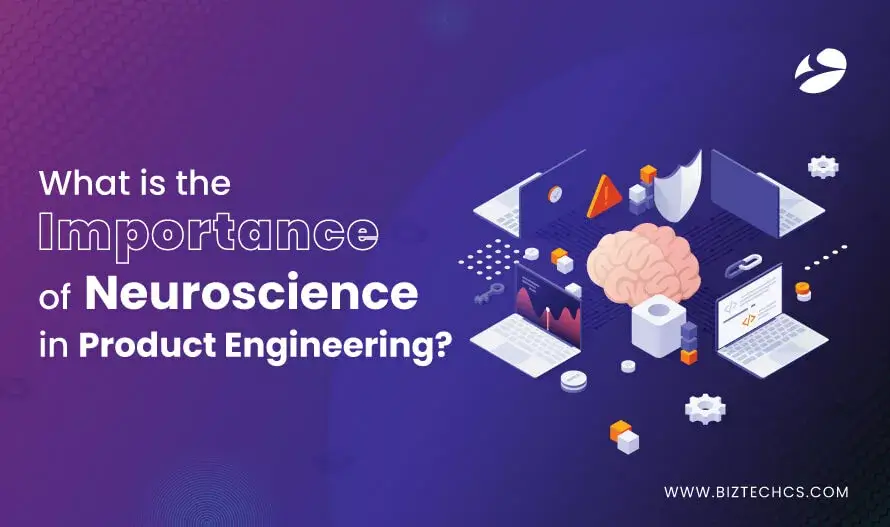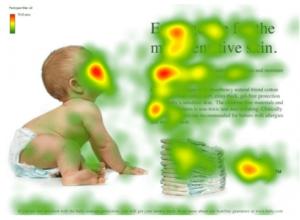2700
What is the Importance of Neuroscience in Product Engineering?
01 Jun, 2023
7 min read
2700
01 Jun, 2023
7 min read
Table of Content

The growth of the global product engineering market is led by the need for faster time to market and continuous innovation. We, as customers, are always looking for better products. Thus, the competition for businesses is cutthroat.
However, the increasing security vulnerabilities and lack of technical knowledge are becoming key obstacles to its market growth. So, it becomes even more essential to innovate different techniques that help devise better products.
Neuroscience in software product engineering is a way to help you create more appropriate and customer-centric products. Here, let’s learn more about Neuroscience and the various steps involved in decision-making.
The scientific study of the human nervous system, its functions, and disorders is termed Neuroscience. And the study of neuroscience helps engineers understand how the human brain work and its effect on cognitive and behavioral functions.
It has several applications right from healthcare and product engineering to Packaging, designing, and Neuroscience marketing.
Today, this blog will cover the various aspects of neuroscience in product engineering.
To begin with, the study of neuroscience helps you understand how to design/develop a particular project. The reason you rely on neuroscience for product engineering is that it helps you determine what is more likable by humans.
You get to study your target audience more precisely and develop a better product that meets your audience’s demands and can address their pain point.
Furthermore, let’s check how Neuroscience marketing and designing works in real life with the help of examples.
The use of neuroscience marketing has been useful to attract audiences by understanding their behavior in the decision-making process. As our human brain has one-third power of a 60 watts light bulb, it is capable of analyzing, deciding, reasoning, and solving a problem. Perception of the subconscious mind plays an important role when deciding. Below is one example.
Example 1: Change of Font Can Impact the Taste of Soup

Fresh And Creamy

Fresh & Creamy
One of the restaurants selling soup did a survey to observe the change in the perception of their audience because of the change in menu font. They changed the font of the menu for their soups to ‘Lucida Sans’ instead of ‘Calibri’.
After changing the font, they asked the audience to fill up the survey form. They were surprised to see how many people wrote that the soup tasted way fresher and creamier than it tastes now. Evidently, we can say that just by changing the fonts, we could make a major impact on the audience’s perception.
Example 2: Put the baby to work

An advertising agency tried to run a baby ad for a skin care product. For that, they placed the baby image in the center first as seen in the above heat map image.
The first impression of the viewers goes to the baby’s face and not the headline and ad copy. On running this ad campaign, it didn’t generate much value for the business.
As this ad was not working, they switched it with a side-facing baby positioned to look at the ad’s headline. Here in the heat map image below, not much has changed except the position of the baby.

So, your audience will also read the headline and the ad for which the marketing is done. From this, we can say that the website ads and headlines should be positioned on the website in such a manner that the viewer’s attention traverse to the intended places.
Decision-Making is a 5-step process for buying a product that is also dependent on cultural, social, individual, and psychological behaviors as mentioned below.
The first step in the decision-making process is to convey to the audience that the product you are trying to sell is having a need in the market.
Once the need/demand is recognized, it is important to let the audience know how they can fulfill their needs through your product. To ensure this information is conveyed appropriately to the right target audience, you need marketing campaigns and purpose-driven branding.
The most important thing is that the need for the product needs to be marketed in a way that there is a problem that needs to be solved with the help of your product in an efficient and easy way.
The second step is to provide the audience with the suitable information that they have been looking for. Suppose the audience is searching on Google for a solution to their laundry problem. Obviously, they will be searching for washing machines.
So, if you are a seller selling washing machines, you should be able to list your products at the top with all its related information for buyers. Whether it is the product image/video description, Google reviews, or video testimonials, a lot of things can influence the buyer’s decision.
Consumers will try to see the alternatives of competing products/services before they make a purchasing decision. This decision will be based on multiple factors.
For instance, a shopper is likely to go to a competitor if the competing product has a relatively less price, more product benefits, more product availability, or a personalized solution in the product.
To overcome such a situation, the product marketing material should stand out from the crowd. It should be capable of portraying how your product is more valuable than your competitors.
Once all the research is done, now the audience will decide to buy the product only if the above steps have been followed correctly and precisely.
The purchase decision is totally based on practical analysis done from the customer’s end. So, you can’t expect to get all the customers to yourself as the market will be captured by various products. Even if you lose some of your audience to competitors, that can be improved.
This is the most important step! Once the customer has purchased the product/service, it is now time to retain those customers. Otherwise, your sales will fluctuate as there won’t be any repeat orders. So, to overcome this scenario, one needs to engage with the customers even after they have purchased from your brand.
You can do so by sharing a feedback form templates to be filled out by shoppers. You can take notes on how can the product and services be improved for the customers in the future and they will also feel more valued.
As mentioned in the above steps, it is important to attract the audience in a way that your product stands out in the market and is chosen by the audience. And our product engineering team can help you design, develop, and market your product the right way.
Read Also: Steps to Understand the Ins and Outs of Product Engineering
Now, if you think every product and industry will work by this 5-step rule, you might be wrong. Not all industries need all the steps for decision-making. Here, let’s look at some of the industry examples for your reference.
In the transportation industry, there is no need for recognition from the audience as they already know the need for transportation services.
So, the first step would be an information search to get the details of transportation services. The shoppers will evaluate and check alternatives to see the services offered by the competition.
The purchase decision will be based on the Google reviews and competitor services offered. You can further improve your post-purchase evaluation to retain customers.
In the petroleum industry, there is no need for recognition, information search, purchase decision, or post-purchase evaluation.
If you ask why, the answer is simple: petrol/diesel/Natural Gas is the basic necessity for daily commute. The industry is mostly run by the government to bring resources from different countries.
Only the quality of the petroleum may change to locations so the audience will look for evaluation and alternatives.
In the agriculture industry, there is no need for recognition, information search, purchase decision, or post-purchase evaluation.
Here also, the government runs most of the agriculture business, which is then sold to the consumers right from farmers. This is also a basic necessity for humans.
As these are necessary products, it is mostly sold as by-products. That’s when the Evaluation and Alternatives step comes into the picture. Here, the audience can get fresh farm vegetables and fruits or Organic vegetables and fruits sold by the competitors.
From the above examples, we can conclude that not all industries require all the phases of the decision-making process. That’s why we say that “Profitable Businesses do not run by following the same processes, profitable businesses run by following the right processes based on the product, market, time, and investment there with the business.”
Human brain works in miraculous ways. And studying behavioral and cognitive functions of the brain with the help of Neuroscience can help you understand the preference and likes of your customers. It can influence your decision and ultimately your product’s sales.
With this article, you should be able to learn the significance of Neuroscience in product engineering. You will also get to realize the various applications of Neuroscience for developing better products and improve your marketing strategies.

Development
327
By Devik Gondaliya
09 Jul, 2025

Odoo
7945
By Biztech
04 Jul, 2025
Odoo
592
By Devik Gondaliya
02 Jul, 2025